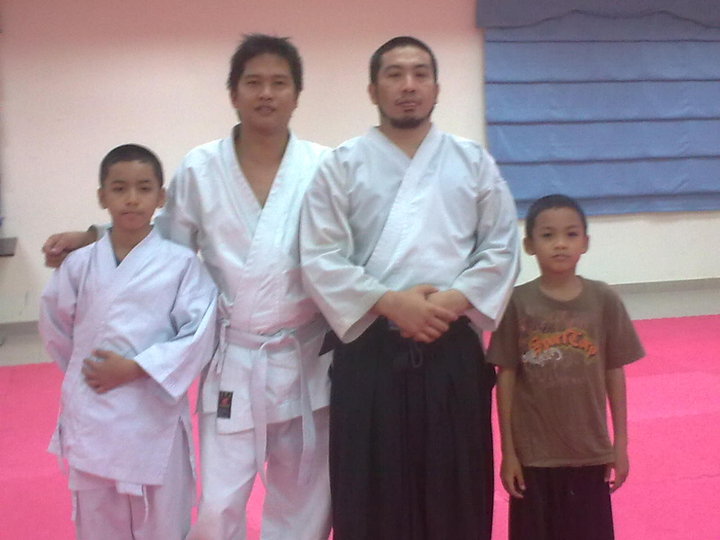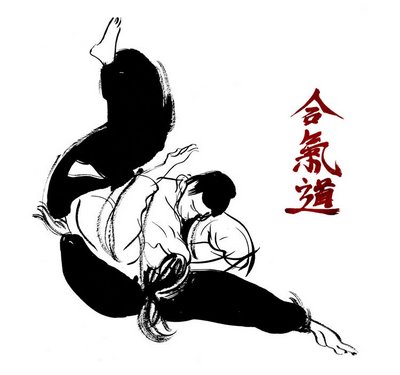
Benefits of Aikido
zainudin sensei believes the true value of Aikido training is embodied in the concept of agatsu, or self-victory. Each practitioner has the freedom to focus on the goals most important to them and to pursue them in a supportive, encouraging, and cooperative learning environment.
Each student is unique and has their own goals and measure of success for their training. However, Aikido practitioners all generally see improvements in the following areas:
*Self-Improvement: Aikido training can increase self-confidence and mental focus.Practice reduces stress,heightens awareness,improves learning skills,and most importantly gives insight into your true self.
*Fitness and Health: Aikido is an excellent activity for improving fitness and health. An active Aikido practitioner can expect to improve core strength, speed,endurance,muscle tone and flexibility. Aikido training also refines body posture in a way that builds balance and coordination.
*Self-Defense: Aikido is a highly effective form of self-defense. The power of Aikido lies in its ability to harness and redirect the force of an attacker, allowing the practitioner to execute powerful techniques without possessing great size or strength.


Aikido is a relatively young Japanese martial art dating from the 1920's when its founder Morihei Ueshiba, began to develop what he eventually came to call Aikido.
Aikido is rooted in the Japanese warrior tradition and incorporates concepts from the Yagyu school of swordsmanship. It is also based on Ueshiba's nearly 20-year study of Daito-Ryu jujutsu which was gentled and transformed by his attachment for the Omote religion and its celebration of life, creation, and loving protection of others. Aikido replaced the maiming and destruction of classic jujitsu with control and compassion.
According to the founder of Aikido, Morehei Ueshiba;
“The art of peace is the principle of nonresistance. Because it is nonresistant, it is victorious from the beginning. Those with evil intentions or contentious thoughts are instantly vanquished. The art of peace is invincible because it contents with nothing.”
Meanwhile according to the official World Aikido Headquarter’s explanation, Aikido is a Budo. It means , ‘a pure Budo comes with the unification of technique, body and heart. The Budo, which will manifest itself, does not depend upon the technique, but rather upon the heart of the practitioner. The aim of Aikido is a kindness of heart expressed through this spirit of Budo’.
Aikido, literally means method or way (do) for Coordination or Harmony (ai) of Mental Energy or Spirit (ki). To elaborate more, here are some thoughts on the spirit of Aikido adopted from Hombu.
The meaning of Aiki (Harmony of Spirit)
Aiki is love. Budo is the path of the warrior. Combined with the spirit of heaven and earth in your heart, you can fulfill your life's destiny with unconditional love for everything. Aiki seeks to skillfully strike down the ego and inherent insincerity in battling an enemy. Aiki is the path of forgiveness and enlightenment. The martial techniques provide discipline for the journey of uniting the spirit and the body through channeling the laws of heaven.
The goal of Aikido training is not perfection of a step or skill, but rather improving one's character according to the rules of nature. One becomes "resilient" inside yet this strength is expressed softly. Movements found in nature are efficient, rational, and soft, while the center is immovable, firm, and stable. This principal of a firm center is universally consistent -- and must be true for each person. The culmination of Aikido is expressed by aligning one's center with the center [Hara] expressed throughout nature.
Aikido movement maintains this firm and stable center [Hara] with an emphasis on spherical rotation characterized by flowing, circular, dance-like motions. These pivoting, entering and circling motions are used to control and overcome the opponent. The principle of spherical rotation makes it possible to defend one self from an opponent of superior size, strength, and experience.
Although Aikido movements are soft, rational, and smooth as in nature, by applying a bit of force, these can become devastatingly effective. The gentle quality of Aikido makes it appealing to men and women and children regardless of age. It not only offers spiritual development but also provides exercise and teaches proper etiquette and behavior.
At the heart of Aikido is the Eastern concept of Ki - the universal creative principle. Aikido seeks to unite this universal Ki with the Ki (life force or breath) found within each person. Literally, Aikido translates as "the way of harmony with Ki".
In summary, Westbrook and Ratti (1970) in their famous book "Aikido and the Dynamic Sphere" described Aikido as "the gentlemens fighting art”. Though it is not an unfamiliar word, few outside the world of the martial arts can distinguish it from various other methods of self-defense. Its trademark, however, lies partly in its sophisticated style and partly in its essential motivations.
Aikido is a method of self-defense which can be used against any form of attack and - at its highest levels - a Discipline of Coordination, a "way" of harmonizing all of man's [and woman's] vital powers. There is no attack in aikido; i.e. its goal is merely to neutralize an aggression and render the attacker harmless, without causing him [or her] any serious injury if at all possible. To do this requires skill, but even more, it requires an ethical intention. The very word aikido, in fact, contains the three elements which comprise the art; "ai", harmony or coordination, "ki", spirit or energy; "do", the method, the way.
A man [or woman] who studies and practices aikido correctly desires only to defend himself [or herself] without hurting others. To possess this attitude, one must achieve a very high level of integration of the powers of mind and body, the harmonious combination of physical means and ethical motives."
The philosophical foundation of Aikido
The founder once said:
Aikido is the way of nonresistance and is therefore undefeatable from the start. Fast and slow are of no consequence. Merely by having the intention to fight with one who embodies the universal law, they have fixed their mind on violating the harmony of nature itself. The person with evil or malicious feeling (jyaki) is defeated before he makes the first move. The content has already been decided.
This being so, in what way can we rid ourselves of this (jyaki) and become pure of spirit and mind? We must unify our mind and feeling with the mercy and compassion of the universal spirit. With love (ai), there is no competition, no enemy, no antagonism towards anyone else or anything. Those whose feeling does not coincide with this mentality can in no way come in harmony with the laws of the universe. (adapted from The Spiritual Foundation of Aikido, William Gleason, 1995)
Functionally, as explained by Shifflett in his book Exercises for Teaching and Training, the internal principle of Aikido aims to subdue and control rather than damage or destroy the opponent while protecting the attacker and the attacked. The Aikidoist does not punch or kick to injure or harm unnecessarily, does not block or resist attacks, but blends with, redirects and transforms the attackers energy maintaining the flow. The result is devastating softness, invisible technique and art that makes no sense to observers accustomed to force against force
The Doshu’s Chronology
Morihei Ueshiba 1883-1969
1883 Born on December 14 in Tanabe city, Wakayama Prefecture, Japan.
1912 Moves to Hokkaido Prefecture and meets Sokaku Takeda, learns Daito-ryu Aiki-Jujitsu.
1919 Meets O. Deguchi of the Omoto Sect in Ayabe, Kyoto.
1927 Moves to Tokyo with his family and begins teaching the Way of Aiki.
1960 Receives the Shiju Hosho Medal from the Japanese government.
1969 Passes away on April 26, at the age of 86.
Kisshomaru Ueshiba 1921-1999
1921 Born on June 27, in Ayabe.
1946 Graduates from Waseda University, Faculty of Economics and Political Science.
1956 Gives the first demonstration and starts to teach Aikido to the public.
1957 Publishes the first textbook AIKIDO.
1969 Assumes the title of Aikido Doshu.
1995 Receives the Zui Hosho Medal from the Japanese government.
1999 Passes away on January 4, at the age of 77.
Moriteru Ueshiba 1951-
1951 Born on April 4, in Tokyo.
1976 Graduates from Meiji Gakuin University, Faculty of Economics.
1996 Becomes General Director of the Hombu Dojo.
1999 Assumes the title of Aikido Doshu.
Aikido in Malaysia
Aikikai Aikido becomes known to Malaysians as early as 1960s. The known official establishment of Aikido teaching sent by Aikikai Foundation to Malaysia was in 1971.
It was when Y.A.B Tun Datuk Patinggi Haji Abdul Rahman Ya’kub, the former Chief Minister of Sarawak requested Aikikai foundation to introduce Aikido to the state. He took the initiative by opening the first official dojo at his residence in Kuching in November 1971. A year later, the Second Doshu, Kisshomaru Ueshiba visited Tun’s and made public demonstration in Kuching.
In 1973, in response to the rapid growth of Aikido in Kuching, Tun made courtesy visit to Aikikai Foundation and was demonstrated in great detail of the art by Kisshomaru Ueshiba. Tun was so impressed of the philosophy behind Aikido that in Aikido there is no competition or loss-win situation and the art is use not to harm but to make more friends. Thus, Tun believed that the philosophy of Aikido teaching resembles in some kinds to the teachings of Islam and can be used as an approach to unite and motivate the Malaysian youths.
The later development was tremendous looking at the rapid acceleration of Aikido teaching and the establishment of Aikikai Malaysia Association. With Aikido as a tool to mobilize youth for healthy activities, BINA was entrusted to monitor the development of Aikido in Sarawak until it spans to the Peninsular of Malaysia. After years of dedicative training, BINA was able to produce excellent local aikido practioners namely Muhammad Haneef Ali 5th Dan, Zainuddin Khalic 3rd Dan, Yusof Sula 3rd, Reza 3rd Dan under the guidance of Aikikai Foundation’s instructor abroad scheme Abdul Rashid Yamada (a.k.a Jun Yamada).
The spread of Aikido from Kuching to Kuala Lumpur and Selangor was initiated by Sensei Zainuddin Abd. Khalic. When he was a graduate student at the International Islamic University Malaysia, he founded IIUM Aikido Club. From this club, many public demonstrations were carried out in the peninsular which attract many to learn the art.
Aikikai Malaysia's connection with the Doshus
When Aikido was taught in Kuching by Hombu’s instructor, in August 1972 the second Doshu, Kisshomaru Ueshiba visited and made his first public appearance and demonstration in Kuching, Sarawak. This was later followed by many trainings and seminars led by instructors from Hombu. The current Doshu, Moriteru Ueshiba visited twice Malaysia and made Aikido demonstration, one in 1989 in Kuching, Sarawak and another in 2001, during the 3oth Anniversary of Aikikai Malaysia Association. The 30th Anniversary was a successful chapter of the development of Aikido in Malaysia rooted from Tun Abdul Rahman Ya’kub’s inspiration .